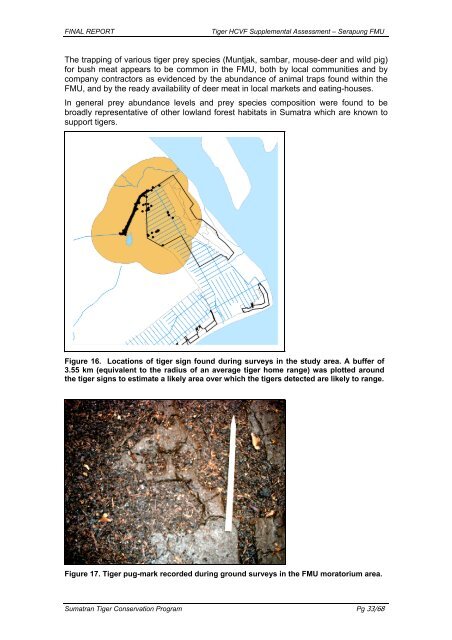A Supplemental HCVF Assessment on the Sumatran Tiger ...
A Supplemental HCVF Assessment on the Sumatran Tiger ...
A Supplemental HCVF Assessment on the Sumatran Tiger ...
You also want an ePaper? Increase the reach of your titles
YUMPU automatically turns print PDFs into web optimized ePapers that Google loves.
FINAL REPORT <strong>Tiger</strong> <str<strong>on</strong>g>HCVF</str<strong>on</strong>g> <str<strong>on</strong>g>Supplemental</str<strong>on</strong>g> <str<strong>on</strong>g>Assessment</str<strong>on</strong>g> – Serapung FMU<br />
The trapping of various tiger prey species (Muntjak, sambar, mouse-deer and wild pig)<br />
for bush meat appears to be comm<strong>on</strong> in <strong>the</strong> FMU, both by local communities and by<br />
company c<strong>on</strong>tractors as evidenced by <strong>the</strong> abundance of animal traps found within <strong>the</strong><br />
FMU, and by <strong>the</strong> ready availability of deer meat in local markets and eating-houses.<br />
In general prey abundance levels and prey species compositi<strong>on</strong> were found to be<br />
broadly representative of o<strong>the</strong>r lowland forest habitats in Sumatra which are known to<br />
support tigers.<br />
Figure 16. Locati<strong>on</strong>s of tiger sign found during surveys in <strong>the</strong> study area. A buffer of<br />
3.55 km (equivalent to <strong>the</strong> radius of an average tiger home range) was plotted around<br />
<strong>the</strong> tiger signs to estimate a likely area over which <strong>the</strong> tigers detected are likely to range.<br />
Figure 17. <strong>Tiger</strong> pug-mark recorded during ground surveys in <strong>the</strong> FMU moratorium area.<br />
<strong>Sumatran</strong> <strong>Tiger</strong> C<strong>on</strong>servati<strong>on</strong> Program Pg 33/68

















